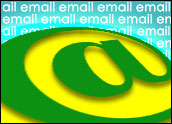
Email has been around since before the Internet, but while the technology itself hasn’t changed much since the 1970s, the volume of it has. Some people, in fact, receive hundreds of messages a day. That’s a threat to a human’s ability to process information.
There are, however, ways to manage email. Here’s how to go about it.
Step 1:
Shut down your in-box if you find emails are distracting you from productive work. You can still be alerted to important messages through an SMS text message.
Set up a “from-based” filter within your email client, such as Gmail, to forward important emails to your phone’s text account. That way, you’ll see the initial 140 characters on the phone as the message comes in and know that you need to open your email client to address the email. Yet you won’t get distracted routinely by less important email.
Tip: This method will only work if you keep your phone’s SMS message functions exclusively for important stuff.
Check your wireless carrier’s website for the email-to-SMS messaging syntax. Sprint’s, for example is [email protected], where the number is your phone number.
Step 2:
Hit the Unsubscribe link embedded in legitimate mass emails and then delete the email without reading it. Gradually your daily volume will decrease — some of those lists are bombarding you frequently.
Tip: Be careful here, because some unscrupulous marketers use the Unsubscribe link to identify your email box as being live. I’ve written about identifying dodgy emails before in How to Identify Bogus Banking Emails and How to Do Your Part in Foiling Spammers.
Step 3:
Avoid distributing your email address, but if you do, use a Burner email.
Unfortunately, marketers looking for prospects to harass have wised-up to the use of completely fabricated email addresses when signing up for services, and won’t let you register for services without a legitimate email.
Burner email addresses are disposable addresses that let you sign up for services and click on the verify link in the sent email; the addresses then vaporize after a predetermined period, like an hour. Guerrillamail.com is one such Web-based solution.
Step 4:
Look for newsletter marketing preferences options whenever you give out your email in a Web-based form and uncheck the boxes.
Tip: The only emails you’ll ever need are the ones related to the account itself — an option often with its own check box. If you ever feel the compunction to learn more about a company, browse to the website instead.
Turn off email notifications from social networks. Look for the options within the account management page.
Step 5:
Take advantage of triaging tricks offered by email services.
Clients like Outlook let you set up hierarchical folders. Add project folders with action and archive subfolders, then drag-and-drop from the in-box as emails come in, for example. Then deal with the email on a project-by-project basis rather than a hit-and-miss chronological one.
Alternatively, use filters to send messages to the project folder, then address the email content as you work on that particular project.
Look for category options within email clients and take advantage of them. Gmail’s newest client on some Android 4.0+, iPhone and iPad devices, for example, lets you categorize by people you actually know. Look for the new Primary tab there.
Tip: Mark certain message senders as Important if your email client lets you do that.
Step 6:
Try some email management software.
Boomerang, a plugin for Gmail, lets you set up reminders if no one replies to your message, so you don’t have to retain tickle items in your in-box.
ActiveInBox, a Gmail extension for Chrome or Firefox, creates professional status and prioritization project management-like elements within Gmail.
Step 7:
Turn the whole process into one big game with The Email Game. This Gmail- and Google Apps-compatible game gives you a score. The faster you clear your in-box, the more points you get.
Want to Ask a Tech Question?
Is there a piece of tech you’d like to know how to operate properly? Is there a gadget that’s got you confounded? Please send your tech questions to me, and I’ll try to answer as many as possible in this column.
And use the Talkback feature below to add your comments!




















































